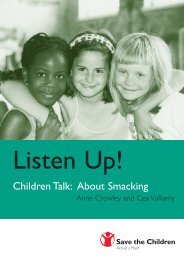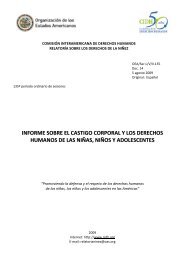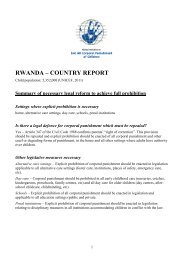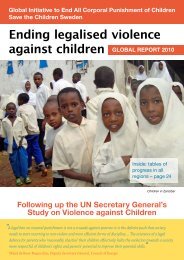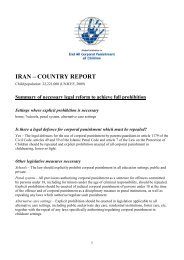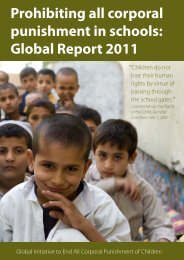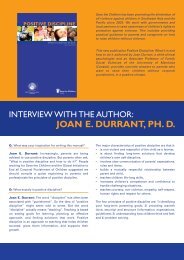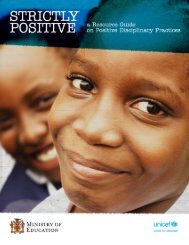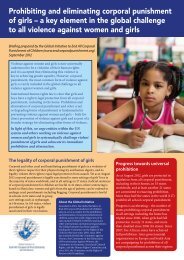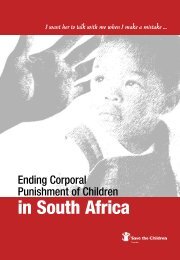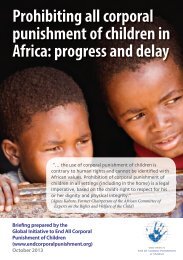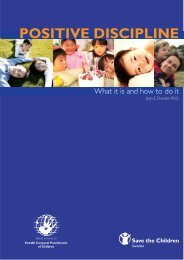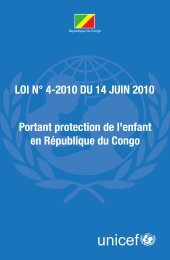Ending corporal punishment of children in Swaziland
Ending corporal punishment of children in Swaziland
Ending corporal punishment of children in Swaziland
- No tags were found...
You also want an ePaper? Increase the reach of your titles
YUMPU automatically turns print PDFs into web optimized ePapers that Google loves.
1. INTRODUCTION“He should talk to me, not beat.” 1Girl, 9-12-year age groupAs <strong>in</strong> so many other countries <strong>in</strong> the world, many <strong>children</strong> <strong>in</strong> <strong>Swaziland</strong> suffer<strong>corporal</strong> <strong>punishment</strong> and other forms <strong>of</strong> humiliat<strong>in</strong>g and degrad<strong>in</strong>g <strong>punishment</strong> <strong>in</strong>the home, <strong>in</strong> the school and <strong>in</strong> different <strong>in</strong>stitutions.Less than 20 countries worldwide have adopted legislation to prohibit <strong>corporal</strong><strong>punishment</strong> <strong>of</strong> <strong>children</strong>. In addition, a number <strong>of</strong> countries have outlawed <strong>corporal</strong><strong>punishment</strong> <strong>of</strong> <strong>children</strong> <strong>in</strong> schools and other <strong>in</strong>stitutions. The global movementto reverse the culture <strong>of</strong> <strong>corporal</strong> <strong>punishment</strong> and other forms <strong>of</strong> humiliat<strong>in</strong>g anddegrad<strong>in</strong>g <strong>punishment</strong> <strong>of</strong> <strong>children</strong> is ga<strong>in</strong><strong>in</strong>g momentum. It is based on a grow<strong>in</strong>gunderstand<strong>in</strong>g <strong>of</strong> <strong>children</strong> as holders <strong>of</strong> rights, and the grow<strong>in</strong>g body <strong>of</strong> evidencefrom medical, educational and psychological authorities on the negative effects <strong>of</strong><strong>corporal</strong> <strong>punishment</strong> and its <strong>in</strong>effectiveness as a method <strong>of</strong> discipl<strong>in</strong>e.Corporal <strong>punishment</strong> <strong>of</strong> <strong>children</strong> violates <strong>children</strong>’s human rights to physical <strong>in</strong>tegrityand human dignity, as upheld by the UN Convention on the Rights <strong>of</strong> the Child(CRC) and the African Charter on the Rights and Welfare <strong>of</strong> the Child (ACRWC).It is the obligation <strong>of</strong> all states around the world to ensure that <strong>children</strong>’s right to alife free from violence, <strong>in</strong>clud<strong>in</strong>g <strong>corporal</strong> <strong>punishment</strong> and other forms <strong>of</strong> humiliat<strong>in</strong>gand degrad<strong>in</strong>g <strong>punishment</strong>, is protected. Children’s right to a life free from violencealso extends <strong>in</strong>to the private life and home <strong>of</strong> the child.Defenders <strong>of</strong> <strong>corporal</strong> <strong>punishment</strong> suggest that <strong>children</strong> are different. But theirdifferences – their dependence, developmental state and fragility – do not reducetheir human rights or justify less protection from all forms <strong>of</strong> violence, <strong>in</strong>clud<strong>in</strong>g<strong>corporal</strong> <strong>punishment</strong>. 2This publication aims to provide <strong>in</strong>formation about <strong>corporal</strong> <strong>punishment</strong> and otherforms <strong>of</strong> humiliat<strong>in</strong>g and degrad<strong>in</strong>g <strong>punishment</strong> <strong>of</strong> <strong>children</strong> <strong>in</strong> <strong>Swaziland</strong>. It outl<strong>in</strong>es<strong>in</strong>ternational obligations to prohibit the <strong>corporal</strong> <strong>punishment</strong> <strong>of</strong> <strong>children</strong> and toengage <strong>in</strong> public education. It provides recommendations on steps to be taken bythe government and civil society to ensure that the culture <strong>of</strong> <strong>corporal</strong> <strong>punishment</strong>and other forms <strong>of</strong> humiliat<strong>in</strong>g and degrad<strong>in</strong>g <strong>punishment</strong> <strong>of</strong> <strong>children</strong> is replaced bypositive, non-violent forms <strong>of</strong> discipl<strong>in</strong>e based on respect for <strong>children</strong>’s rights.In this publication, a child is referred to as a person below the age <strong>of</strong> 18 years <strong>in</strong>accordance with the CRC.5



